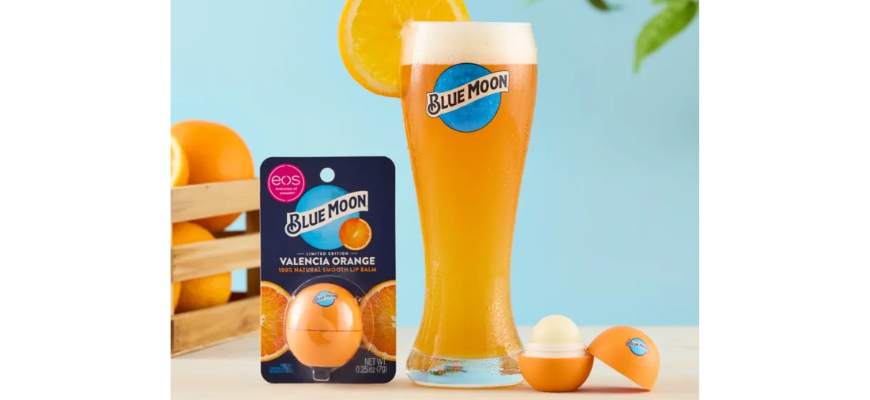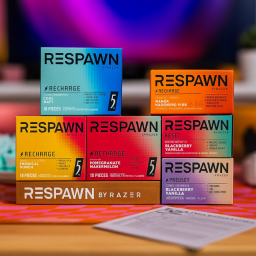
In June 2025, Blue Moon Brewing Company and eos (Evolution of Smooth), the popular personal care brand known for its lip balms, launched an unexpected and buzzworthy collaboration: the “Your Lips’ New Main Squeeze” Valencia Orange Lip Balm. This limited-edition product is inspired by Blue Moon’s signature Valencia orange garnish and aims to capture the beer brand’s citrus-forward flavor profile in lip care form. The product is being marketed as a fun summer collectible, attracting both craft beer enthusiasts and beauty aficionados alike.
This isn’t Blue Moon’s first foray into brand collaborations, but it marks a notable expansion beyond the beverage aisle. The company, owned by Molson Coors Beverage Company, has experimented with experiential marketing in the past, such as pop-up taprooms and seasonal activations. eos, for its part, is no stranger to creative partnerships. The brand has previously collaborated with influencers, celebrities, and even other consumer packaged goods (CPG) brands, but this partnership with a beer company pushes category boundaries in a bold new direction.
According to statements from both brands, the collaboration is designed to evoke the sensory experience of enjoying a Blue Moon beer with a slice of orange, but in a beauty product format. The lip balm features a Valencia orange scent and is packaged in eos’s signature spherical container with Blue Moon’s recognizable branding. The launch is limited, creating a sense of exclusivity and urgency among fans of both brands. It also serves as a marketing event that aligns with summer drinking occasions and festival season.
Co-Branding Beyond Categories: Legal Roadmap for Unexpected Brand Pairings
Cross-industry collaborations like the Blue Moon x eos partnership raise unique legal and business challenges. Co-branding between distinct product categories requires careful contractual, regulatory, and intellectual property planning.
Key Legal Considerations:
- Trademark Licensing & Usage Rights: Each party must clearly define how logos, trademarks, and brand elements will be used. This includes placement, size, duration of use, and quality control provisions to prevent brand dilution or misuse.
- Brand Integrity and Control: Both brands need mechanisms to maintain quality standards. For instance, Blue Moon would likely want assurances that the lip balm meets specific safety and consumer satisfaction benchmarks to protect its reputation.
- Product Liability & Indemnification: Since this product is applied to the body, eos assumes regulatory and product liability risks. Agreements should include indemnification clauses to address potential claims arising from product defects or allergic reactions.
- Regulatory Compliance: A beer-flavored or -branded lip balm may raise concerns with regulators about marketing alcohol-related products to minors. Careful labeling and marketing guidelines are critical to mitigate risk.
- Territorial Restrictions: The partnership should outline where the product will be sold, ensuring compliance with local laws regarding alcohol branding on personal care products.
- Termination & Post-Term Use: The contract must address what happens when the promotion ends. Will unsold inventory be destroyed? Can packaging be repurposed? These considerations help prevent post-campaign conflicts.
Practical Checklist for Cross-Industry Brand Collaborations:
- Conduct a full IP audit to identify trademarks, trade dress, and proprietary elements involved.
- Draft detailed licensing and collaboration agreements with clear quality control provisions.
- Analyze potential regulatory pitfalls (e.g., FDA, FTC, alcohol marketing restrictions).
- Address insurance and indemnity clauses to allocate risk appropriately.
- Define specific marketing and distribution channels to avoid brand confusion or consumer backlash.
- Set clear timelines and procedures for launch, marketing review, and termination.
- Include dispute resolution mechanisms in case of partnership disagreements.
Strategic Benefits & Brand Equity Considerations in Beverage–Beauty Partnerships
From a strategic perspective, collaborations like this are designed to generate viral buzz and reach new consumer segments. However, they come with inherent brand equity risks.
Opportunities:
- Expanded Consumer Base: Blue Moon reaches beauty consumers; eos gains exposure to craft beer enthusiasts.
- Social Media Virality: Quirky partnerships generate attention on platforms like TikTok and Instagram, especially when tied to limited-edition drops.
- Seasonal Sales Boost: Summer is peak season for both beer consumption and outdoor beauty needs like lip balm with SPF or hydration.
Risks:
- Brand Dilution: Unexpected pairings can confuse consumers if not well-executed.
- Target Audience Misalignment: There’s a risk of alienating core customers if the collaboration feels off-brand.
- Supply Chain Complexities: New product categories may require different manufacturing, packaging, and compliance protocols.
- Post-Collaboration Fallout: If the partnership underperforms or sparks controversy, it can lead to reputational harm.
Balanced Framework for Evaluating Co-Branding Deals:
- Audience Overlap: Are the customer bases compatible or complementary?
- Brand Fit: Does the collaboration align with each brand’s values and tone?
- Legal Compliance: Are there any regulatory concerns, particularly in industries like alcohol and personal care?
- Exit Planning: What mechanisms are in place to gracefully end the partnership?
- Marketing Strategy: How will the product be positioned to avoid consumer confusion or backlash?
- Risk Mitigation: Are legal protections in place for liability, IP rights, and enforcement?
FAQs: Co-Branding Across Industries
Q: Can any two brands collaborate on a co-branded product?
A: Yes, but a successful co-branded product requires more than just mutual interest. The brands must carefully align on values, target audiences, and strategic goals. Without proper planning, collaborations can lead to consumer confusion, brand dilution, or legal disputes.
Q: What are the main legal risks in cross-category collaborations?
A: The key legal risks include trademark misuse, failure to comply with regulatory requirements (particularly in regulated industries like alcohol or personal care), product liability exposure, and reputational harm from misaligned branding.
Q: Do collaborations like Blue Moon x eos require FDA approval?
A: Products like lip balm fall under FDA oversight for safety and labeling, but they typically do not require pre-market approval. However, the product must comply with FDA regulations regarding ingredient disclosure, safety testing, and marketing claims.
Q: How do brands protect themselves in these deals?
A: Protection starts with well-drafted contracts. These should include detailed IP licensing terms, indemnification provisions, quality control requirements, clear marketing guidelines, and defined termination rights to safeguard both parties.
Q: Can co-branding lead to long-term partnerships?
A: Absolutely. While many collaborations begin as limited-time promotions, successful partnerships can evolve into ongoing relationships or even new product lines. However, it’s wise to start with clear performance benchmarks and review periods.
Conclusion
The Blue Moon and eos partnership is an example of creative brand strategy that pushes the limits of traditional co-branding. For business owners, especially those considering collaborations outside their primary industry, this case study underscores the importance of strategic alignment and robust legal planning.
At Juris Law Group, we help businesses structure innovative partnerships like these with a focus on proactive risk management and brand integrity. If you’re considering a cross-industry collaboration, connect with us to discuss how to structure your next big idea while safeguarding your brand.




